I gave a talk on games and meaning at GDC 2023, which is now available on YouTube:
However, I fully scripted the talk ahead of time, so I decided it would be worth taking the time to post the slides online, in three parts to have mercy on your browser.

Hi everyone, I’m Soren Johnson, and welcome to You Have No Idea How Hard It Is To Run A Sweatshop

Here are the published games that I’ve worked on over my career, some of which I will touch on over the next hour.

I also do a podcast where I interview game designers about why they make games, and the episodes tend to run long, so check it out if you have any 4-hour road trips coming up.
So, the talk I am about to give is something of a sequel to one I gave in 2010 entitled Theme is Not Meaning. I argued then that we need to stop assuming that a game’s theme or SETTING determines its meaning and, instead, that meaning comes from the mechanics themselves. Since then, I’ve spent a lot of time thinking about games which do a good job of constructing meaning from their mechanics and also about ones which do it poorly. I’d like to talk about some of these examples today and examine how best to build meaning in our games. Games have great power to affect players but, and I’m going to be bringing this up over and over again, that power can so easily slip out of the designer’s hands and sometimes end up delivering the exact opposite message from what the designer intended.
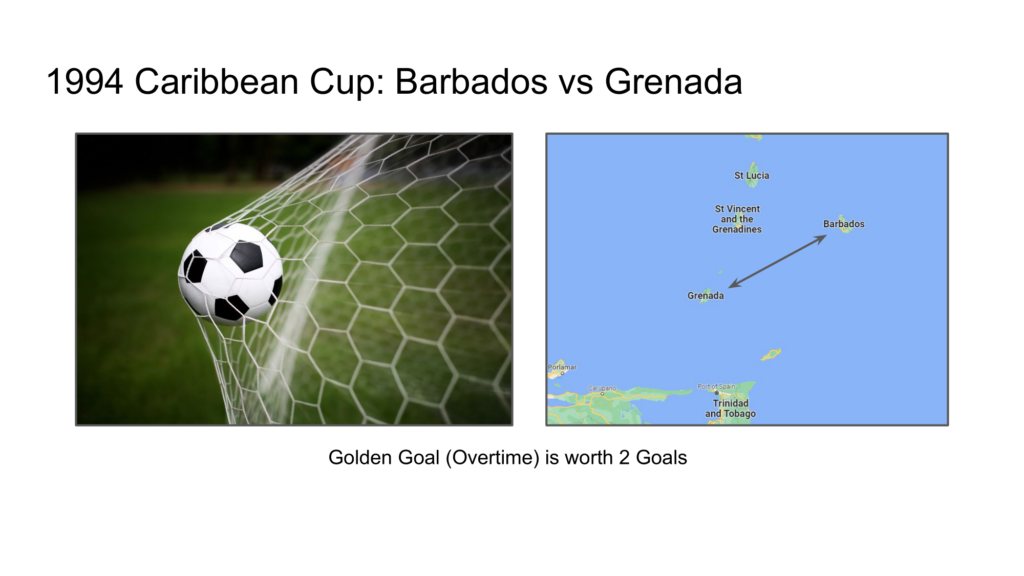
First, let’s talk about soccer and the 1994 Caribbean Cup, where they introduced a unique rule concerning Golden Goals, which are overtime goals that instantly end the game. In this tournament, Golden Goals would now be worth 2 goals instead of 1, which could matter if two teams are tied in the standings and need to use the difference in goals scored as the tiebreaker.
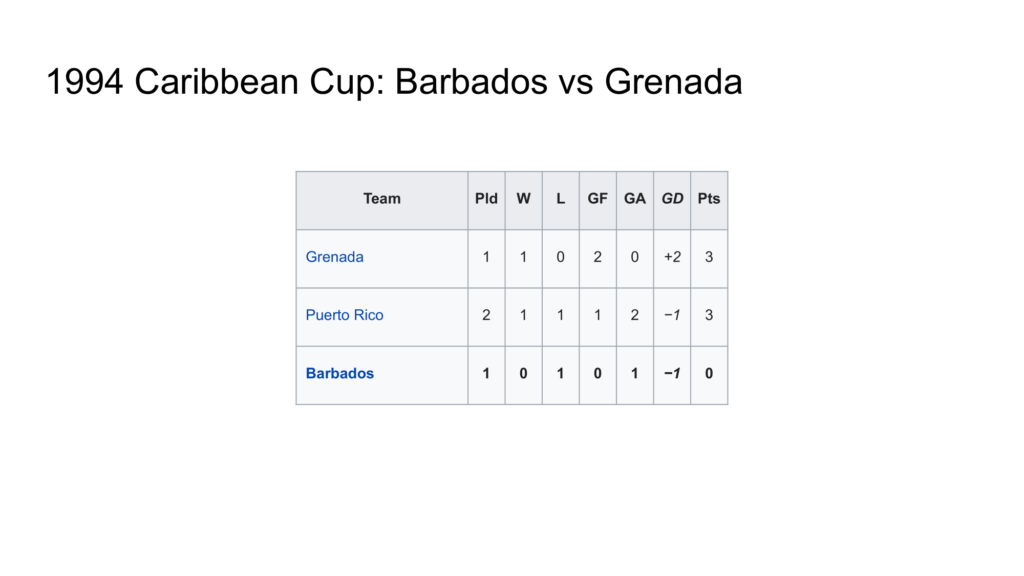
So, here are the standings before the final game between Barbados and Grenada.
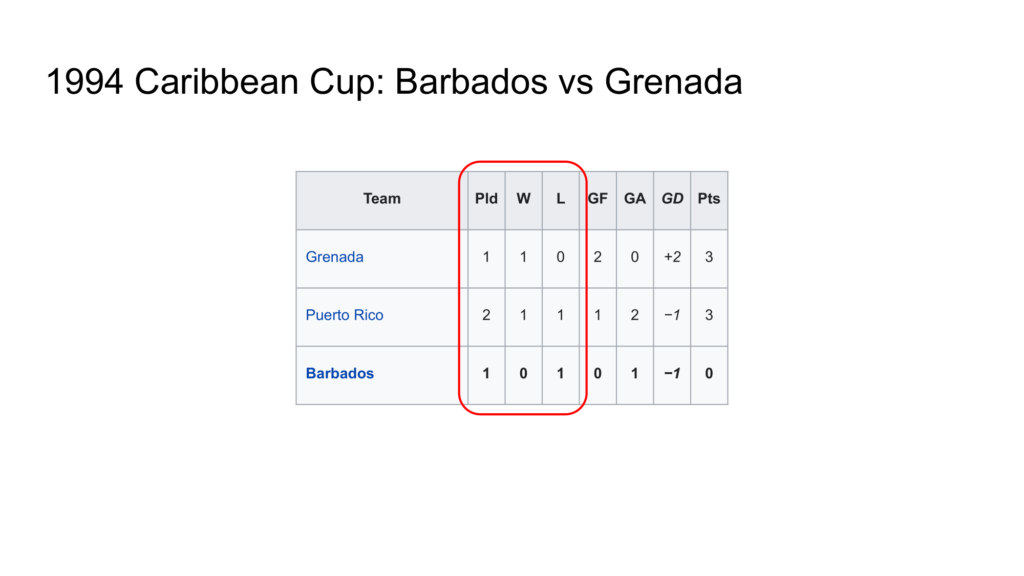
Let me explain what we are looking at here. These columns are the number of games played and the wins and losses so far. Note that if Barbados beats Grenada, there will be a three-way tie.
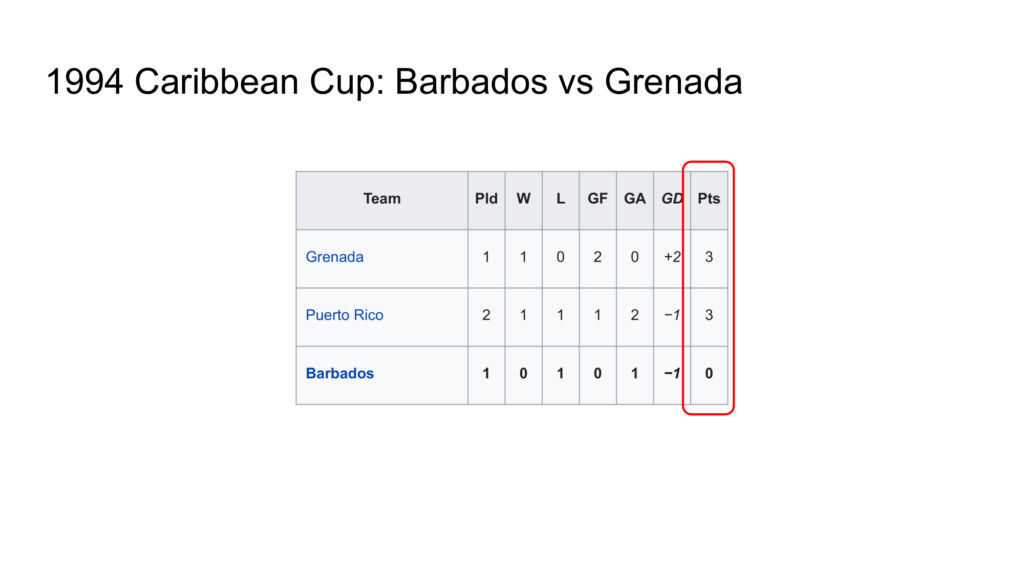
In a three-way tie, each team will have 3 points in the standing because each win is worth 3 points.

So, in the event of a three-way tie, the team which advances is the one with the best Goal Differential, which is Goals For subtracted by Goals Allowed.
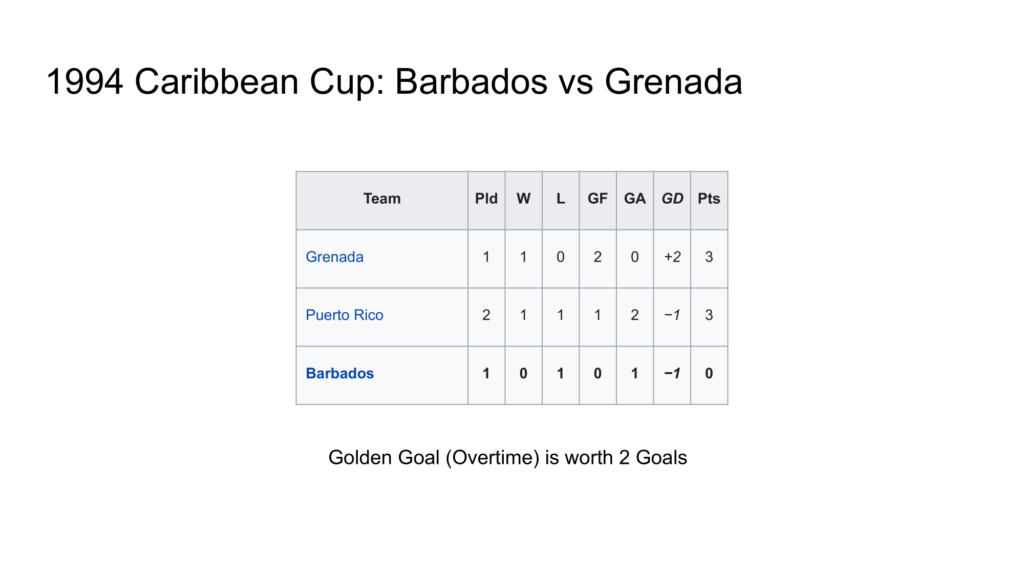
Thus, even though Barbados is currently in last place here, if they can beat Granada by two goals, they will advance from their group by having the highest goal differential. Remember when I said earlier that a Golden Goal is worth double? That’s called foreshadowing.
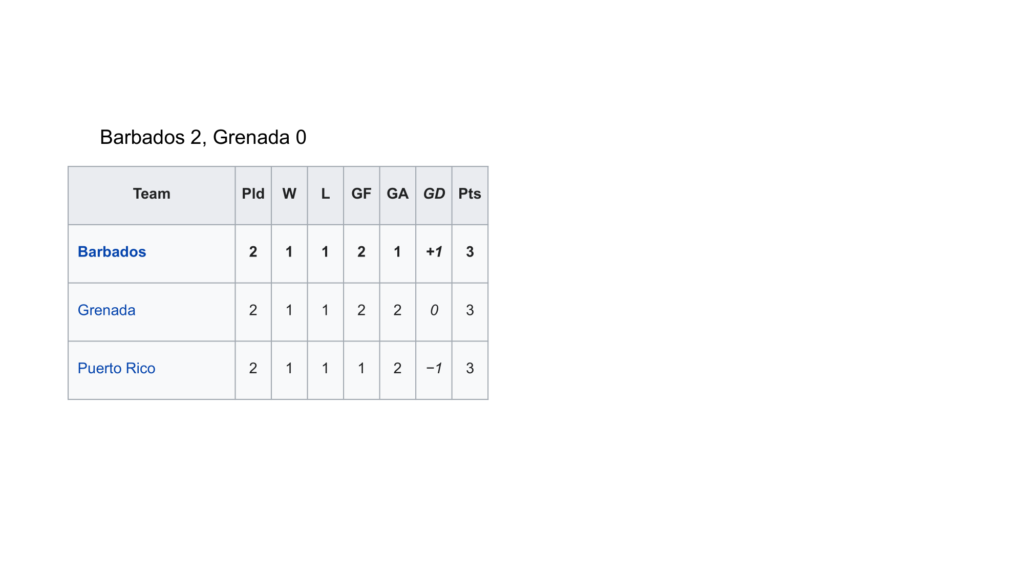
Near the end of the game, Barbados is up by exactly two goals, with a score of 2 to 0, so if the game were to end at that moment, Barbados would have the goal differential they need to win the tiebreaker.
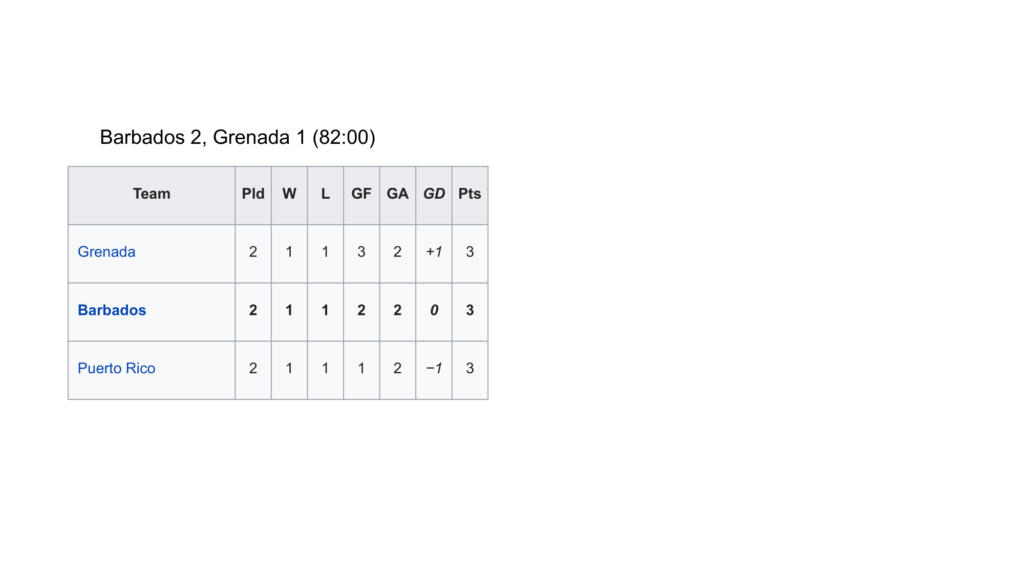
But then, in the 82nd minute, Grenada scores and, even though Barbados is still winning the game, they will not advance because they have lost a point in goal differential. Barbados needs another goal, or they will be eliminated.
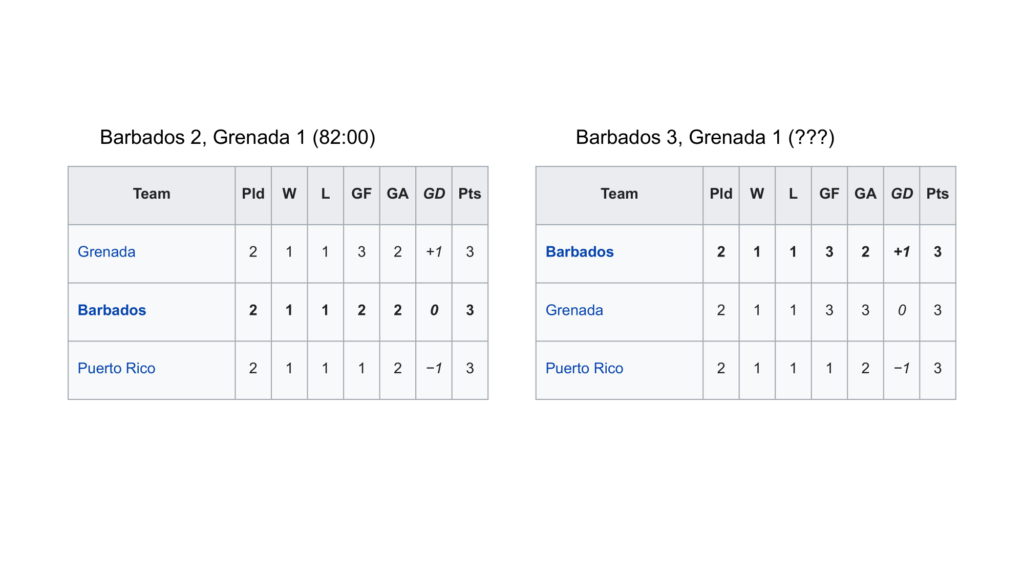
So, if Barbados can score a third goal in the final eight minutes of the game, the standings will look like the chart on the right, Barbados will get back to a +1 goal differential, win first place, and advance to the next round.
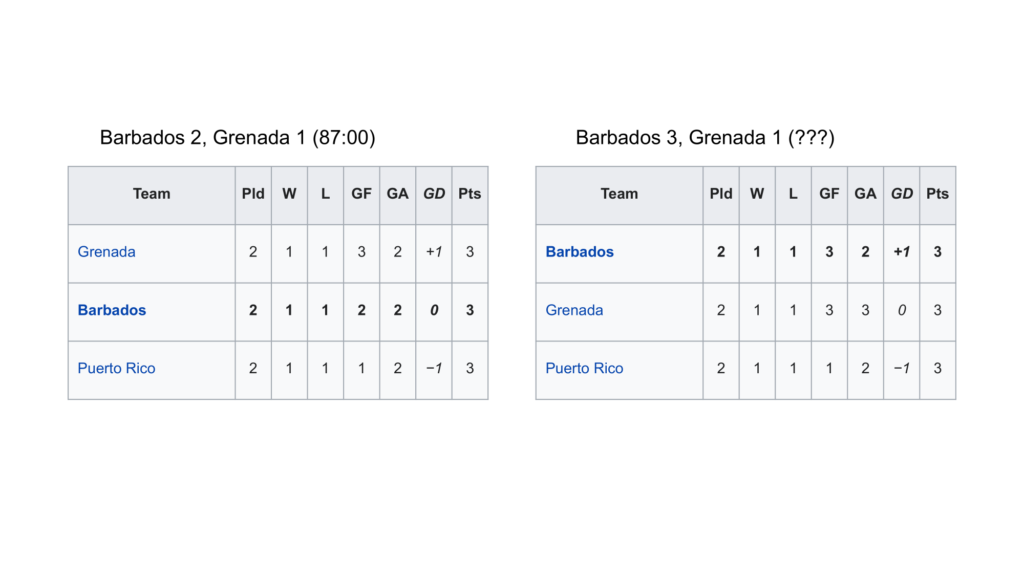
Five minutes pass, and Barbados is running out of time to score the third goal they need. If nothing changes, they will win the game but be eliminated.
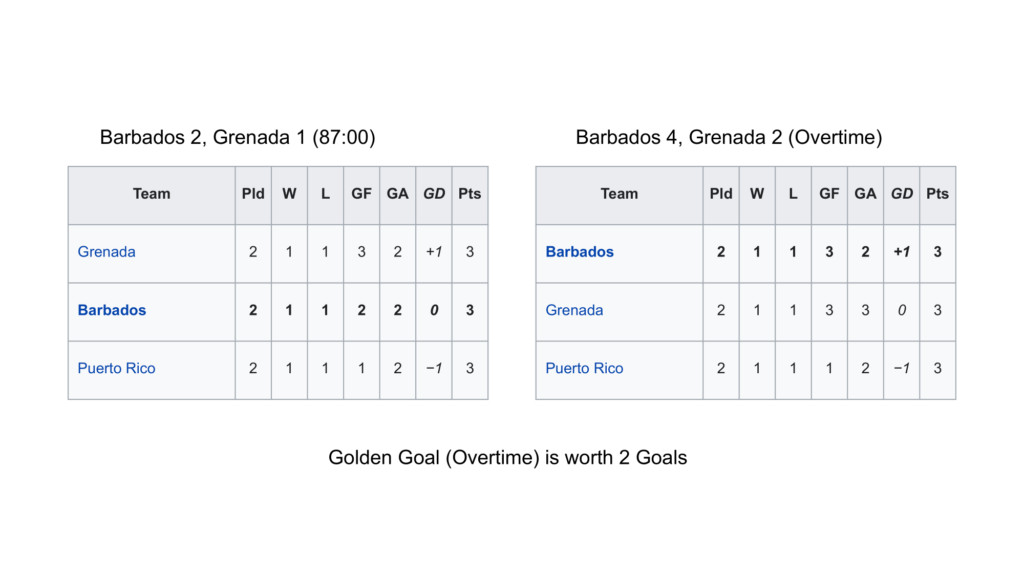
However, someone on the Barbados team remembers the special Golden Goal rule and realizes that if they score on themselves and force the game to overtime, they would have a full thirty minutes to score a Golden Goal which would then be worth two goals and put Barbados into first place as you can see on the right. And so this happens…
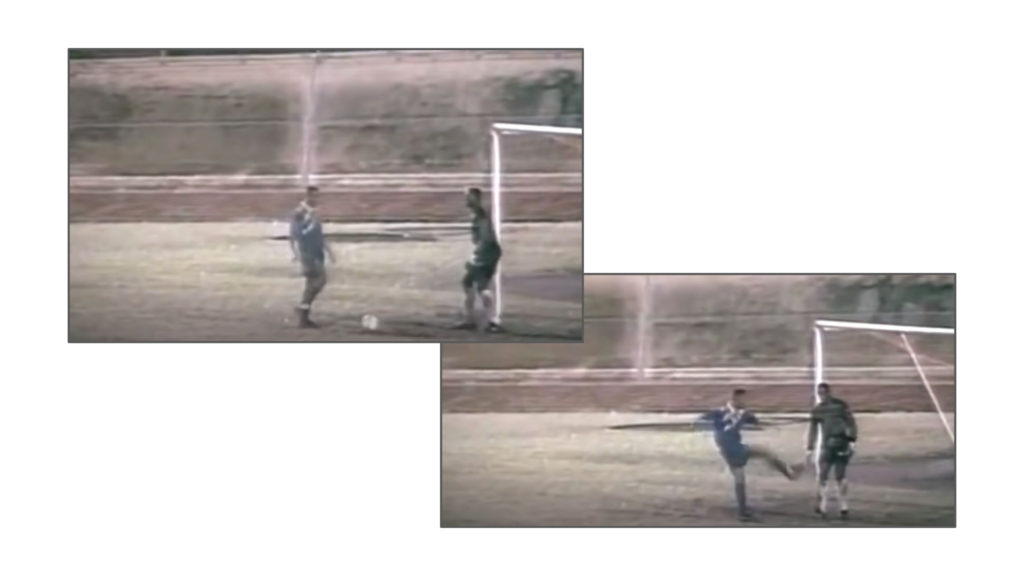
Barbados brings the ball back to their own side and intentionally scores on themselves.
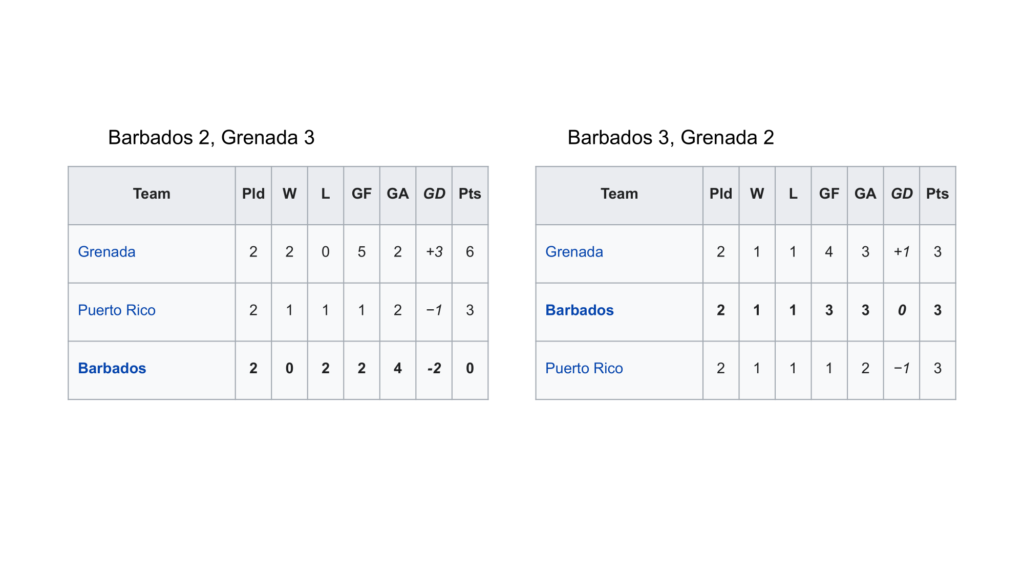
Obviously, Grenada figures something is up, and they quickly realize that they now have two very different paths to first-place, represented by both charts here. Either they score a goal to break the tie – you know, the old-fashioned way – OR INSTEAD they intentionally score on themselves to lose the game but win the group by goal differential.
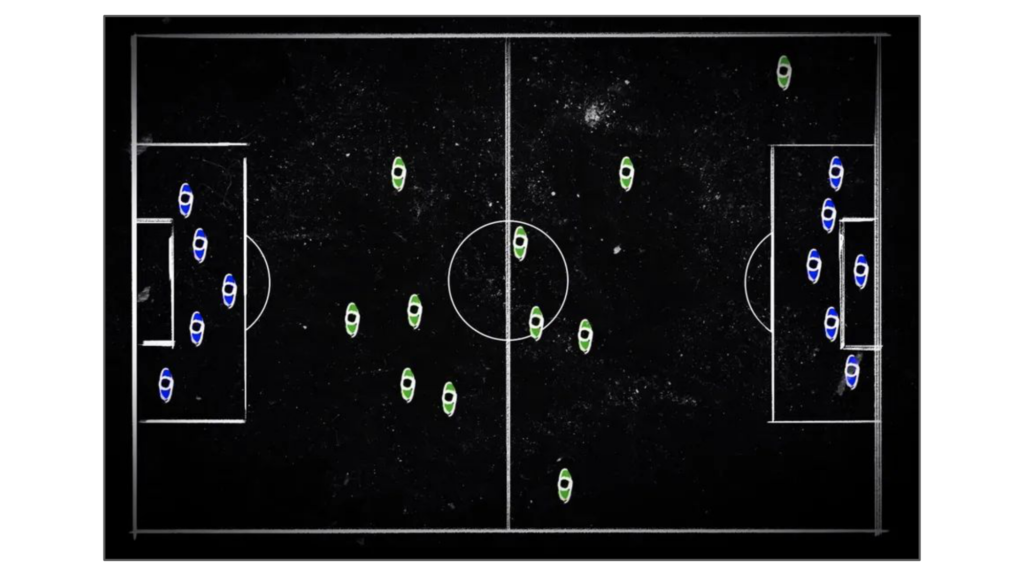
Which leads to what must be the most unusual soccer game of all time because Barbados now needs to defend BOTH of the goals, and Grenada just needs to score in either one, leading to this totally, totally normal arrangement of players.
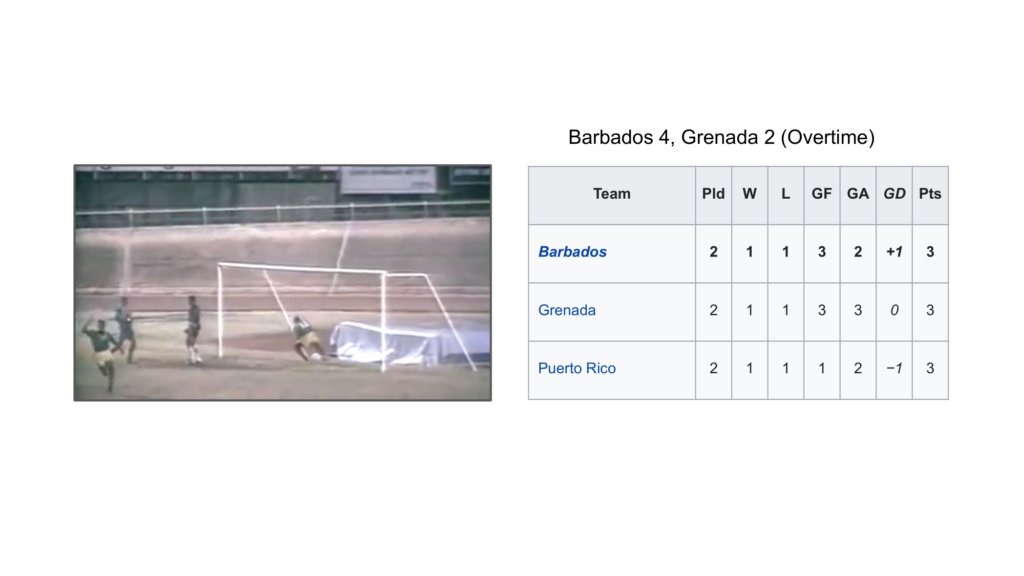
Ultimately, Grenada fails to score in either goal, and the game goes to overtime. Naturally, Barbados does score a Golden Goal, now worth double, and goes onto the next round. Their plan to score on themselves and win in overtime actually worked.
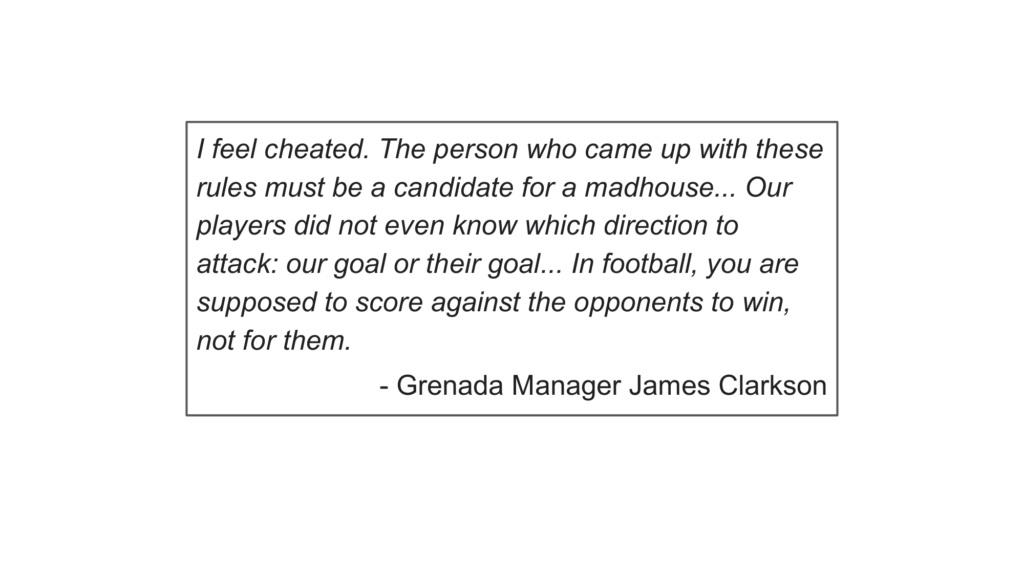
Here is the response of the Grenada manager to this outcome:
I feel cheated. The person who came up with these rules must be a candidate for a madhouse…. Our players did not even know which direction to attack: our goal or their goal… In football, you are supposed to score against the opponents to win, not for them.
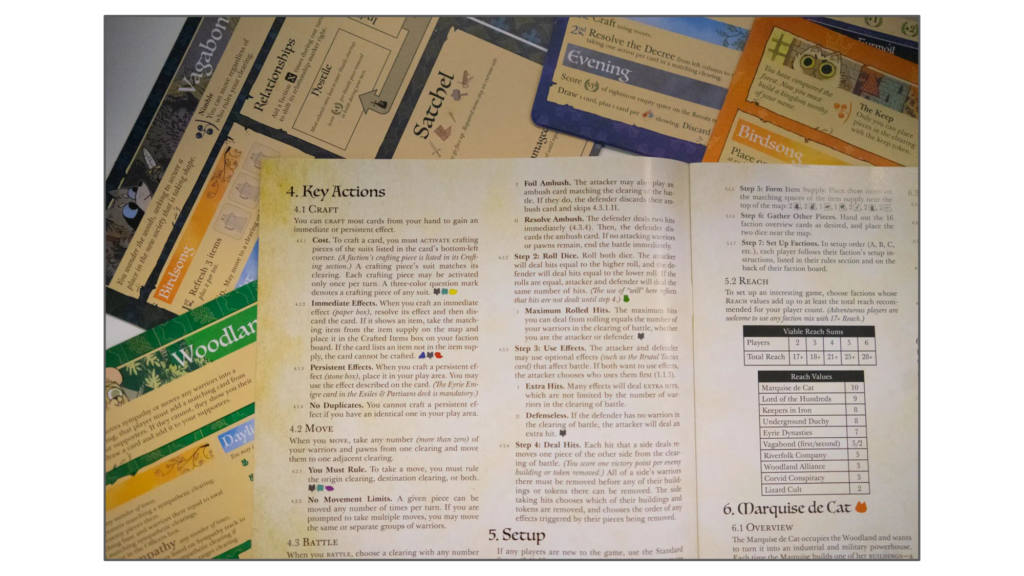
Of course, Barbados did nothing wrong. They are just playing by the rules of the game, and the rules put them in a situation where scoring against themselves made sense. I’ve certainly had the same experience where a rule or mechanic I’ve added to a game ends up creating a perverse incentive that leads to the exact opposite player behavior that I wanted to encourage.

One way to put this is that nobody knows anything.
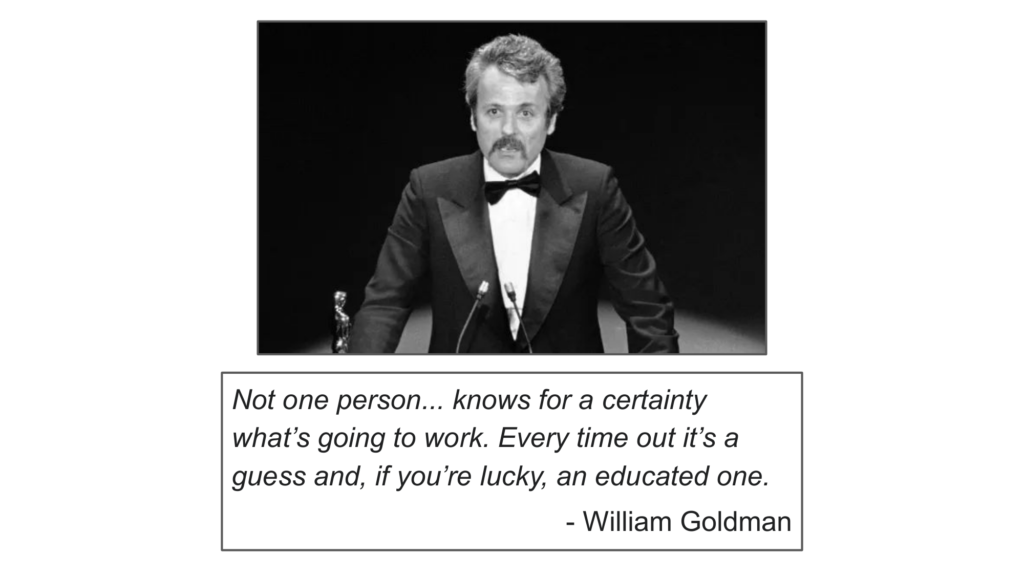
Here’s the rest of the quote from screenwriter William Goldman – Not one person knows for a certainty what’s going to work. Every time out it’s a guess and, if you’re lucky, an educated one.

Certainly, that can be said for video games. I would never have bet on a ultra-detailed dwarf simulator using ASCII art.
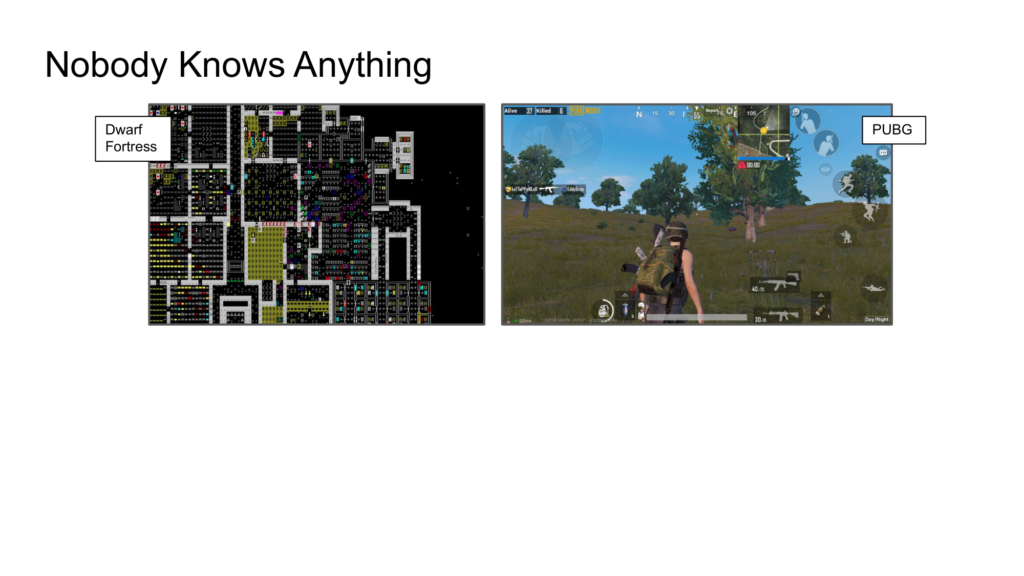
Or on a game with 1 winner and 99 losers.
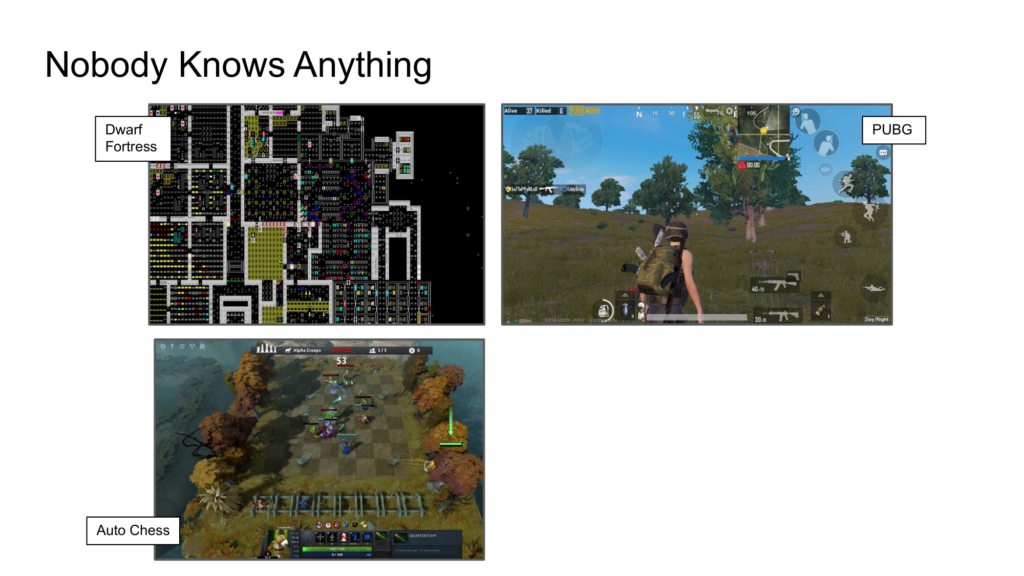
Or on a turn-based game that plays by itself.
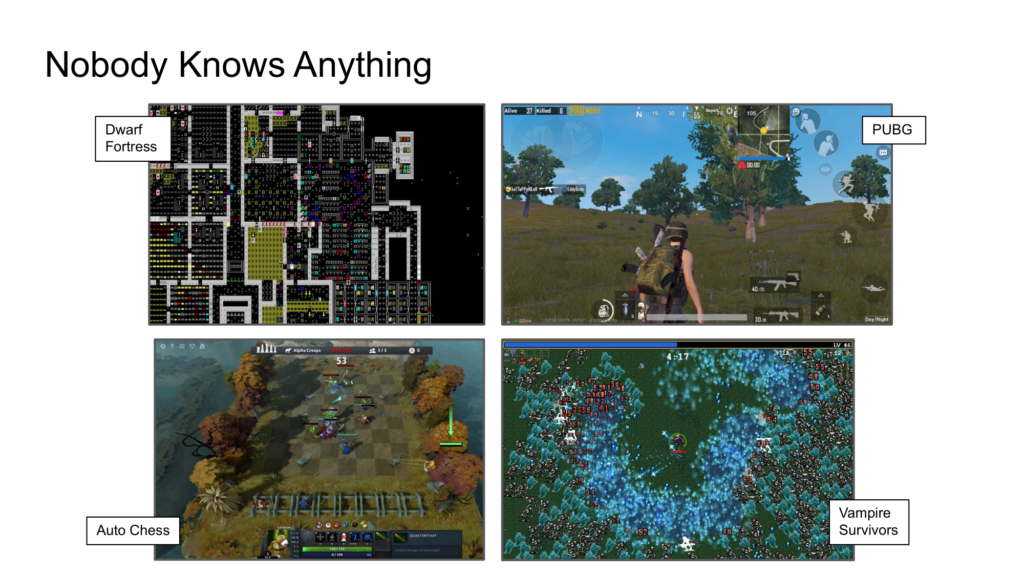
Or on a twin-stick shooter minus one of the sticks.
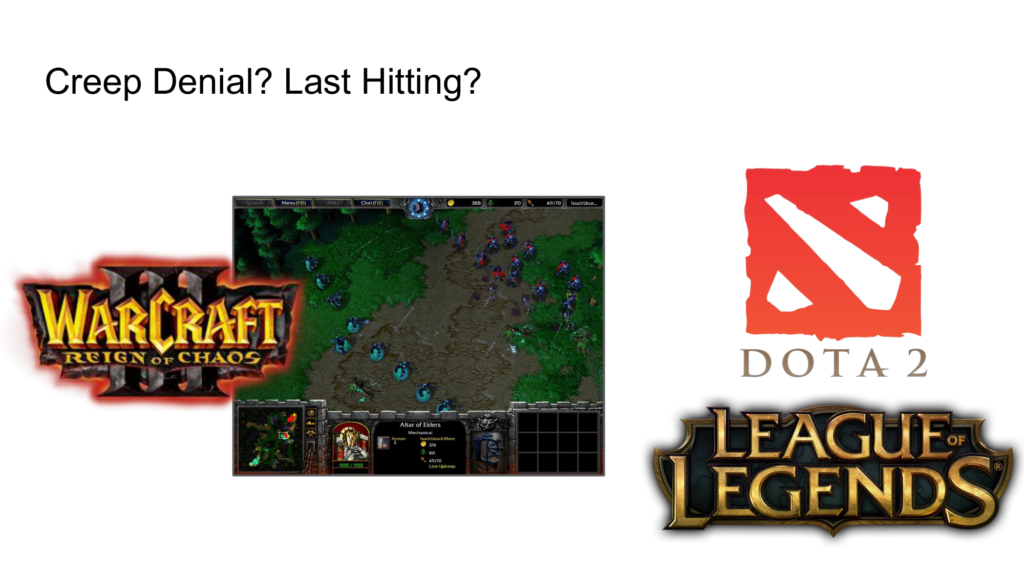
Much of game design is determined by constraints which are out of the hands of the developers. DOTA 2 and League of Legends both inherited their design from the original Warcraft 3 mod Defense of the Ancients, which had two distinctive mechanics that were just baked into how Warcraft 3 worked – Creep Denial (which means being able to kill your own minions) and Last Hitting (meaning that the experience points go to the last hero to hit the target). Dota 2 kept Creep Denial, and both games kept Last Hitting, which suggests that their existence is a happy accident as no one actually quote-unquote designed them. They were just inherited constraints from a game in a different genre.
So, is game design just sorting through accidents like this to see what works?
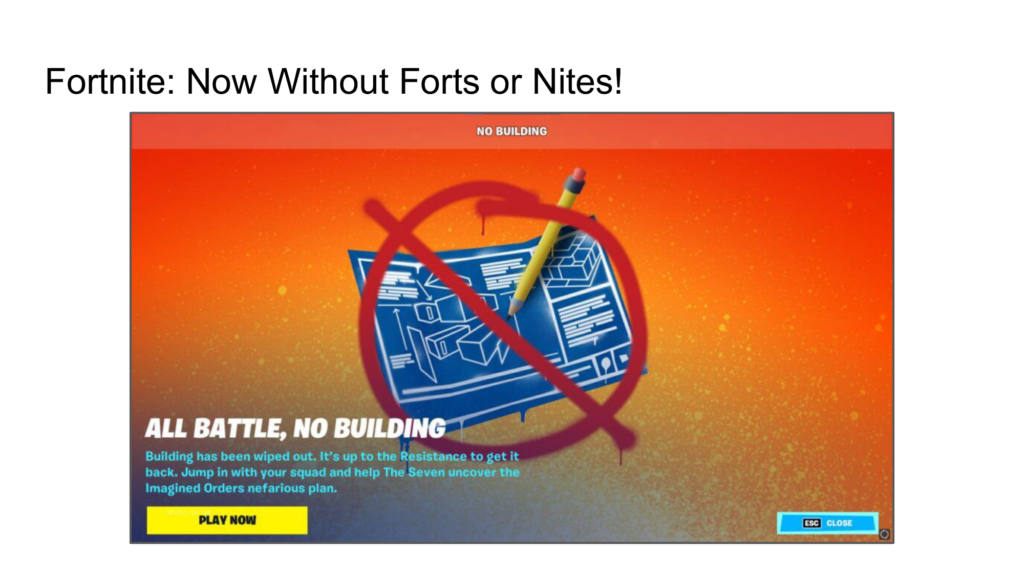
Consider the case of Fortnite, which started as a game about building forts while fighting off waves of zombies. Even after Fortnite blew up into the world’s largest battle royale game, these building mechanics stuck around as this weird, inherited vestige of the original game. It took Epic years to finally do the obvious thing and just get rid of them entirely so that the end of a Fortnite death match was no longer this strange, frantic building contest.
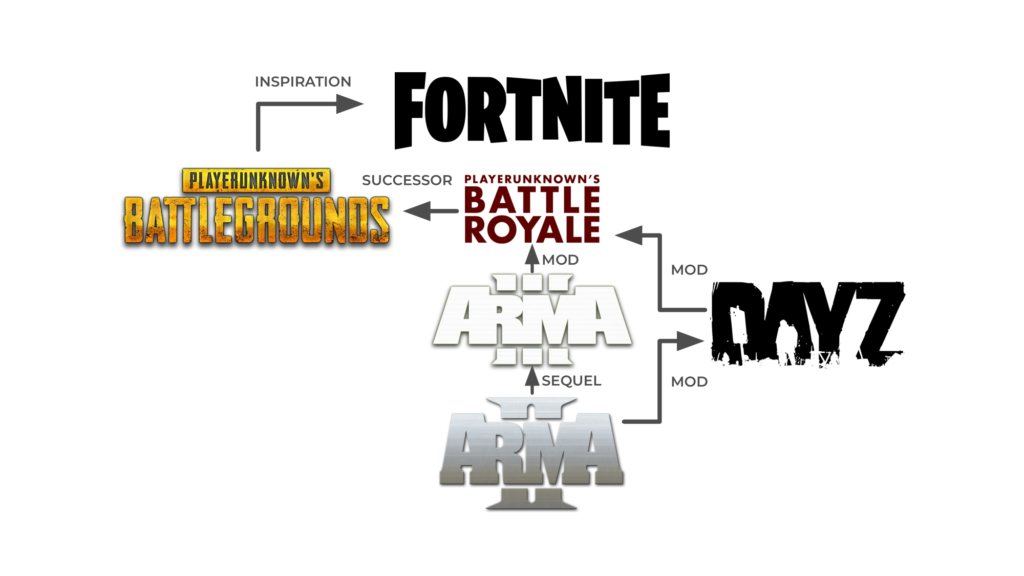
Indeed, it’s hard to describe Fortnite as intentional design at all when you draw out the strange path things took. Here is a rough history of the various games and mods that led to Fortnite Battle Royale as we know it today. Arma is a realistic tactical shooter while DayZ is a free-form survival game while PUBG is a 1-vs-100 cage match. Nobody planned this all out – it just happened. Fortnite was more discovered than designed.

So, when we design a game, are we really just throwing darts? Do we have any idea what we are doing?
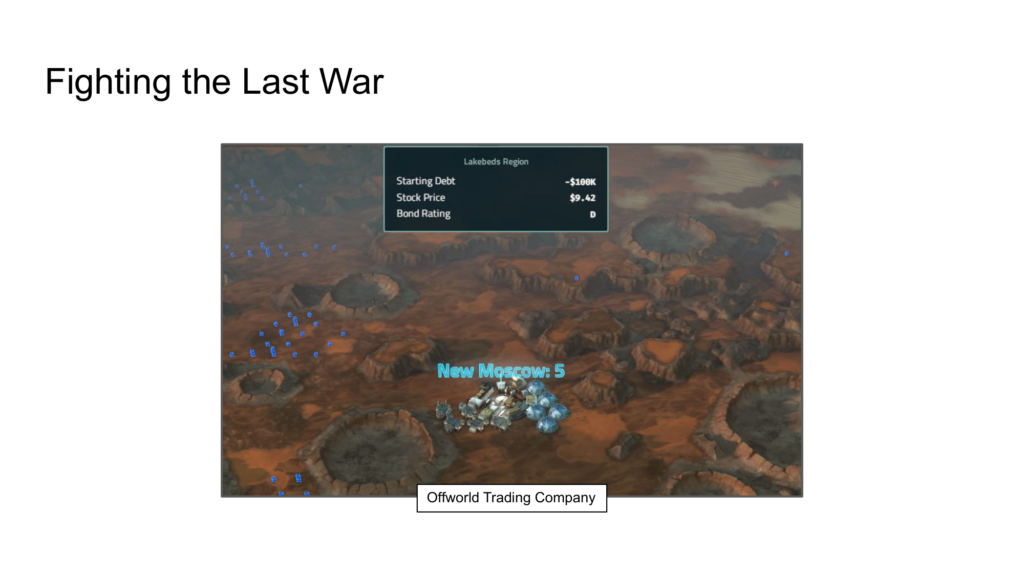
Another problem with game design is that we often overcorrect from whatever lesson we just learned. With Offworld Trading Company, because the game had random maps, each game started with a short exploration phase where you scan the map and found your colony with only part of the terrain revealed. We learned quickly during Early Access that the multiplayer community didn’t want exploration at all because it added luck, and they wanted NO LUCK at the game’s start, so we added a mode with a fully revealed map for these players.
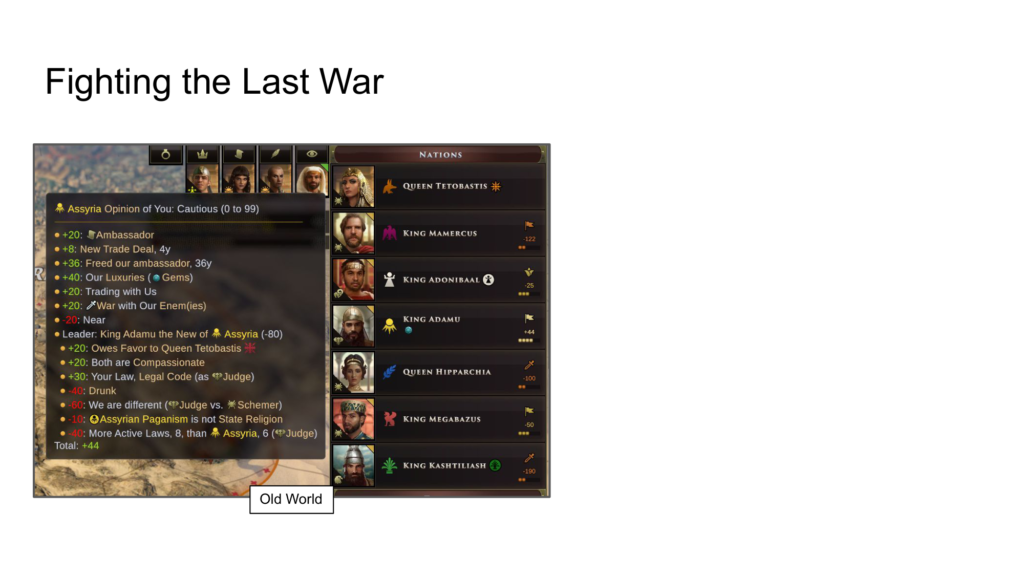
When we built Old World’s multiplayer, we assumed that we would have a similar multiplayer community which would want us to minimize randomness. So, at great effort we maintained a…
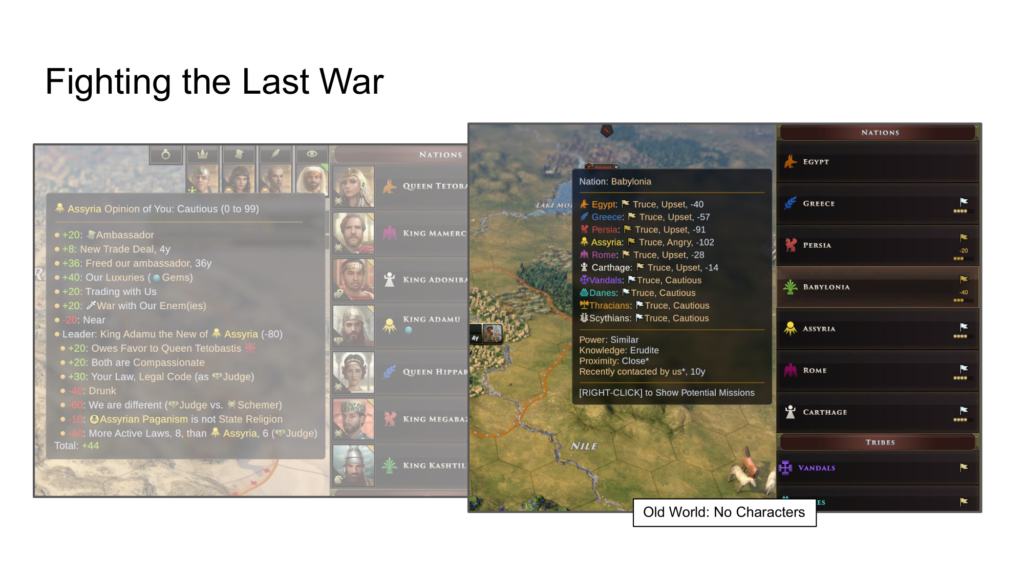
…No Characters mode where the game has literally no characters, no events, no families, nothing that could add randomness to the game. However, almost no one uses this mode. To our surprise, the multiplayer community loves the randomness; they love seeing and adapting to fresh events each game.
The lesson here is that every game finds a unique subset of players from the audience that you think you are targeting and from the ones that you aren’t.
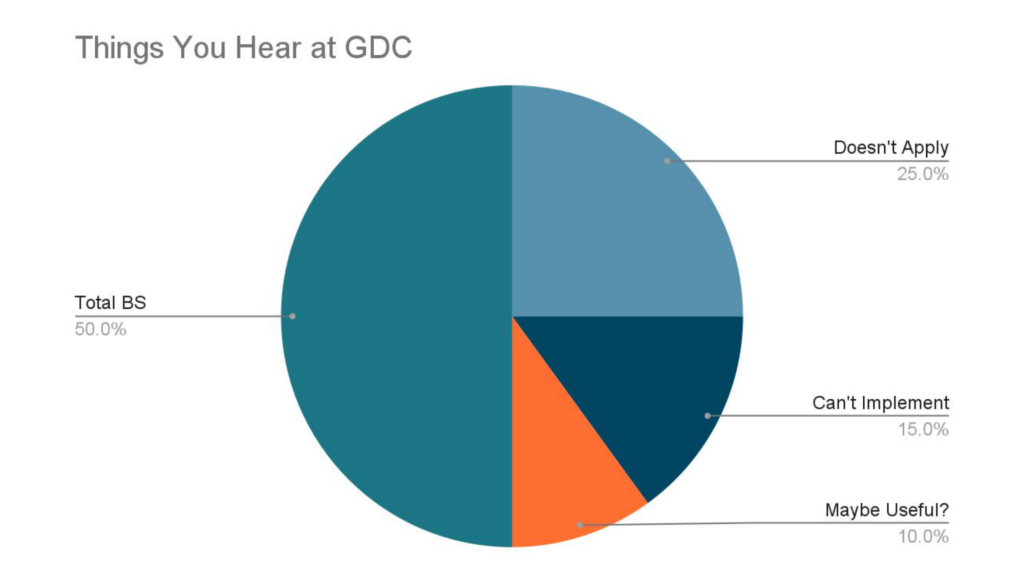
You might have made the same mistake if you had listened to my GDC Offworld Postmortem. None of us really know what we are doing. Remember that at GDC, we are all talking about why we THINK we were successful not why we actually were successful, which is essentially unknowable. Half of what you hear at GDC is BS. Half of the rest doesn’t apply to your game. Most of what remains you can’t implement. The rest might be useful, maybe? Keep in mind, this chart itself might also be BS.

For an example of the type of thing you might have heard at GDC that turns out to be wrong, we’ve been told for years by product managers that people buy cosmetics in free-to-play games so that they can peacock, to show off their skins in front of everyone else. Well, in Valorant, all animations, graphical effects, and sounds are only visible to the purchaser. Your enemies don’t see them. So, it turns out that people will pay for cosmetics even if they are the only ones who can see them.

Pingback: You Have No Idea How Hard It Is To Run A Sweatshop, Part 2 | DESIGNER NOTES
hl1y23
zsj4xg